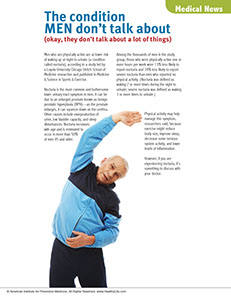SYMPTOM CHECKER
CONDITIONS
Male
Female
Child
Arm, Hand & Shoulder Concerns
Legs & Feet Concerns
Dental & Mouth Concerns
Ear & Nose
Eye Conditions
Head Conditions
Arm, Hand & Shoulder Concerns
Legs & Feet Concerns
Front
Back
Arm, Hand & Shoulder Concerns
Dental & Mouth Concerns
Ear & Nose
Eye Conditions
Head Conditions
Arm, Hand & Shoulder Concerns
Dental & Mouth Concerns
Ear & Nose
Eye Conditions
Head Conditions
Front
Back
Arm, Hand & Shoulder Concerns
Neck Links
Head & Neck Concerns
Arm, Hand & Shoulder Concerns
Neck Links
Head & Neck Concerns
Front
Back
Online Clinic
Wise Healthcare
The condition men don’t talk about
Print on Demand
Men who are physically active are at lower risk of waking up at night to urinate (a condition called nocturia), according to a study led by a Loyola University Chicago Stritch School of Medicine researcher and published in Medicine & Science in Sports & Exercise.
Nocturia is the most common and bothersome lower urinary tract symptom in men. It can be due to an enlarged prostate known as benign prostatic hyperplasia (BPH)—as the prostate enlarges, it can squeeze down on the urethra. Other causes include overproduction of urine, low bladder capacity, and sleep disturbances. Nocturia increases with age and is estimated to occur in more than 50% of men 45 and older.
Among the thousands of men in the study group, those who were physically active one or more hours per week were 13% less likely to report nocturia and 34% less likely to report severe nocturia than men who reported no physical activity. (Nocturia was defined as waking 2 or more times during the night to urinate; severe nocturia was defined as waking 3 or more times to urinate.)
Physical activity may help manage this symptom, researchers said, because exercise might reduce body size, improve sleep, decrease some nervous system activity, and lower levels of inflammation.
However, if you are experiencing nocturia, it’s something to discuss with your doctor.
This website is not meant to substitute for expert medical advice or treatment. Follow your doctor’s or health care provider’s advice if it differs from what is given in this guide.
The American Institute for Preventive Medicine (AIPM) is not responsible for the availability or content of external sites, nor does AIPM endorse them. Also, it is the responsibility of the user to examine the copyright and licensing restrictions of external pages and to secure all necessary permission.
The content on this website is proprietary. You may not modify, copy, reproduce, republish, upload, post, transmit, or distribute, in any manner, the material on the website without the written permission of AIPM.
2021 © American Institute for Preventive Medicine - All Rights Reserved. Disclaimer | www.HealthyLife.com
















































